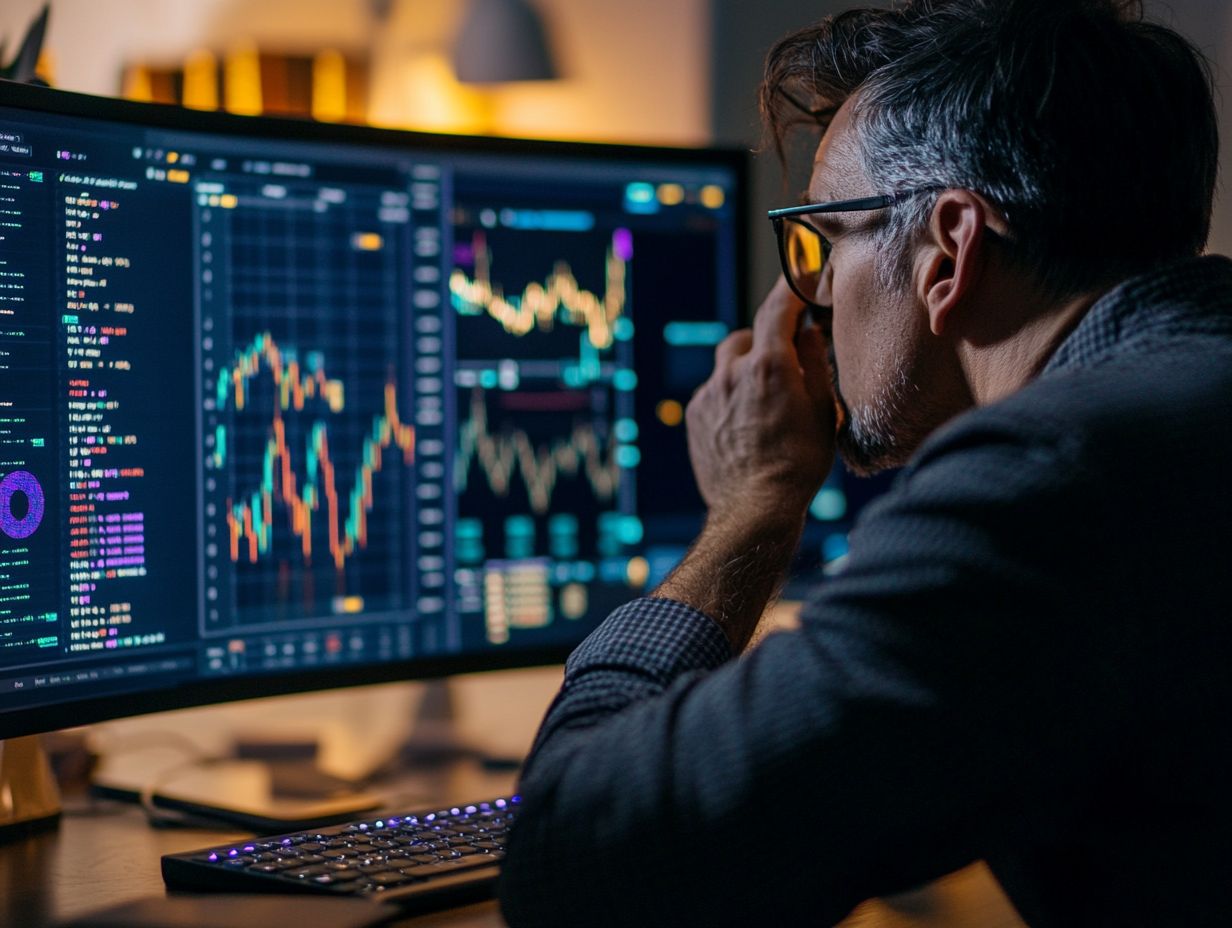The Role of Feedback Loops in Trading Psychology
Trading transcends mere numbers and charts; it is profoundly shaped by your mindset. Grasping the intricacies of trading psychology is essential for attaining consistent success. Feedback loops play a crucial role in influencing your emotional and decision-making processes.
This article delves into the dynamics of feedback loops both positive and negative and their effects on your trading performance. By mastering the management of these loops, you can refine your decision-making skills and elevate your overall trading effectiveness.
Dive into these game-changing strategies to supercharge your trading journey and unlock your full potential!
Contents
- Key Takeaways:
- The Basics of Trading Psychology
- The Importance of Feedback Loops in Trading
- Types of Feedback Loops in Trading
- How Feedback Loops Affect Trading Performance
- Ways to Manage Feedback Loops in Trading
- Frequently Asked Questions
- What are feedback loops in trading psychology?
- How do feedback loops affect trading performance?
- What are some common negative feedback loops in trading psychology?
- How can traders break negative feedback loops?
- Can feedback loops be beneficial in trading psychology?
- How can traders use feedback loops to improve their trading performance?
Key Takeaways:

- Feedback loops play a crucial role in trading psychology, impacting decision-making and emotions.
- Understanding and managing both positive and negative feedback loops can lead to improved performance.
- Strategies for breaking negative loops and utilizing positive loops will empower traders to take control of their trading psychology now!
The Basics of Trading Psychology
Trading psychology plays a pivotal role in shaping your decision-making processes. It influences how you interpret market conditions and ultimately affects your investment behavior. Understanding mental frameworks can greatly impact market dynamics and investor sentiment.
This area of study delves into key factors, including emotional drivers and thought patterns that affect your decisions, that can trigger irrational exuberance or panic amid market volatility. Such reactions often create a feedback loop, amplifying market behavior and affecting overall investor confidence.
Understanding this psychological landscape can empower you to navigate the complexities of trading with greater insight and composure.
Understanding the Mental Aspect of Trading
Recognizing the mental aspect of trading requires understanding how trader psychology, emotional drivers, and thought patterns shape your investment behavior and the overall market conditions.
For instance, overconfidence might tempt you to underestimate the risks tied to your investments, leading to excessive trading or stubbornly holding onto losing positions, convinced that the market will eventually swing in your favor. Similarly, loss aversion can cause you to react irrationally; you might hesitate to sell a declining asset to avoid realizing a loss, unwittingly deepening your financial decline.
These psychological tendencies not only influence your individual decision-making but also create ripples throughout the market. As collective behaviors manifest, they can distort the delicate balance of supply and demand, potentially igniting volatility in the process.
The Importance of Feedback Loops in Trading
Feedback loops are crucial in trading, serving as mechanisms that can either bolster or disrupt market dynamics. These loops present themselves in two ways: positive feedback, where rising prices boost investor sentiment and prompt further buying, and negative feedback, where falling prices incite panic selling.
Grasping the intricacies of these loops is vital for crafting effective trading strategies that can anticipate the self-perpetuating cycles woven into the fabric of financial markets.
Definition and Role in Trading Psychology

In trading psychology, feedback loops are self-reinforcing cycles that arise from thinking errors, emotional triggers, and market dynamics. Understanding the role of routine in trading psychology can significantly shape your behavior as a trader.
They can lead you to bolster or undermine your decisions based on past experiences. For instance, after a profitable trade, you might feel a rush of excitement that fosters overconfidence, nudging you to take on larger risks.
On the flip side, if you face repeated losses, fear may set in, pushing you toward overly cautious behavior that could stifle your potential gains.
Thinking errors like loss aversion and confirmation bias play crucial roles in these feedback mechanisms, often trapping you in emotional reactions. A prime example is the dot-com bubble, where rampant optimism fueled widespread buying, creating an unsustainable feedback loop that eventually burst, resulting in significant losses for many investors.
Types of Feedback Loops in Trading
In trading, you ll encounter two primary types of feedback loops: positive feedback loops that amplify rising trends, and negative feedback loops that temper declining ones. Each plays a vital role in shaping the market dynamics.
Grasping these loop interactions will supercharge your trading strategy and improve your decision-making process.
Positive and Negative Feedback Loops
Positive feedback loops in trading occur when climbing asset prices spark further buying, potentially creating asset bubbles. In contrast, negative feedback loops arise when falling prices incite panic selling, often leading to a market crash.
You can see these dynamics clearly in the markets. Once a bullish trend takes off, both individual investors and institutional players feel an undeniable urgency to jump on the bandwagon, driven by the fear of missing out (FOMO).
As prices begin to decline, fear can swiftly take hold, prompting traders to exit their positions in a hurry. This is often driven by thinking errors such as loss aversion and herd mentality.
This behavior magnifies swings in market sentiment and emphasizes the substantial impact psychological factors have on price movements. Ultimately, these elements play a crucial role in shaping your trading strategies and risk management decisions.
How Feedback Loops Affect Trading Performance
Feedback loops play a crucial role in shaping your trading performance, as they directly influence your decision-making processes. Understanding the emotional cycle of trading can help you recognize these loops, which are often fueled by emotional drivers, leading to increased market volatility that you must navigate carefully.
Impact on Decision Making and Emotions

The influence of feedback loops on your decision-making and emotions in trading can lead to significant shifts in your behavior as an investor. You’re often swayed by thinking errors and skewed perceptions of market conditions.
These loops create a cycle where you reinforce your beliefs based on past outcomes, making it difficult to detach from your initial interpretations of market signals. For instance, confirmation bias may prompt you to seek information that aligns with your existing views while ignoring any contradictory evidence.
This behavior further entrenches your choices. These dynamics can also trigger emotional responses like overconfidence or fear, significantly impacting your risk appetite.
These biases not only influence your decisions but can also affect the entire market, amplifying volatility and influencing overall trading dynamics.
Ways to Manage Feedback Loops in Trading
Managing feedback loops in trading is crucial for maintaining a stable trading environment. It requires you to implement effective trading strategies and risk management techniques that can counteract thinking errors.
By doing so, you create a more balanced approach, allowing you to navigate the complexities of the market with greater confidence and precision.
Start implementing these strategies today to see a positive impact on your trading performance!
Strategies for Breaking Negative Loops
Breaking negative feedback loops in trading requires targeted strategies. Implement effective risk management practices to address emotional drivers and cognitive biases.
You might often find yourself caught in cycles of poor decision-making. Fear and overconfidence can lead to significant financial setbacks.
To combat these tendencies, establishing clear trading plans is crucial. By defining your entry and exit points, you create a framework that helps reduce impulsive decisions.
For instance, a stop-loss order is an instruction to sell a security when it reaches a certain price, helping to minimize losses. This can limit potential losses and ease your anxiety during market fluctuations.
Incorporating regular reflection sessions into your routine can enhance emotional regulation. Evaluating past trades encourages a focus on learning rather than reacting emotionally.
By becoming aware of cognitive biases like confirmation bias, you can actively seek out diverse opinions or data that challenge your assumptions. This ultimately fosters a more rational approach to your trading activities.
Using Positive Loops to Improve Performance
Positive feedback loops can dramatically boost your trading performance. This approach taps into investor sentiment and reinforces upward price movements.
You can create a self-sustaining cycle where increased buying activity drives prices higher. This attracts even more buyers eager to capitalize on anticipated gains.
Take, for example, a rally sparked by positive earnings reports. Momentum trading strategies will encourage you to buy as prices rise.
This initiates a snowball effect, with additional traders piling in, resulting in sharper price increases.
Employing technical indicators that signal bullish trends allows you to further harness this positive sentiment. By understanding how these feedback loops operate, you can strategically position yourself to capitalize on elevated investor confidence.
This ultimately enhances your overall trading outcomes.
Frequently Asked Questions

What are feedback loops in trading psychology?
Feedback loops in trading psychology refer to the cyclical relationship between a trader’s thoughts, emotions, and actions. These loops can be positive, leading to improved performance, or negative, resulting in detrimental effects on decision-making.
How do feedback loops affect trading performance?
Feedback loops can significantly impact trading performance. They can reinforce either positive or negative behaviors, improving decision-making or resulting in impulsive and irrational trading decisions.
What are some common negative feedback loops in trading psychology?
Common negative feedback loops include fear of missing out (FOMO), revenge trading, and confirmation bias. These patterns can lead to emotional trading, chasing losses, and ignoring important information, resulting in poor performance.
How can traders break negative feedback loops?
Breaking negative feedback loops requires self-awareness and discipline. Traders can overcome these patterns by implementing risk management strategies and adhering to a trading plan.
Can feedback loops be beneficial in trading psychology?
Yes, feedback loops can be beneficial. Positive feedback loops can reinforce disciplined behavior, encourage learning from mistakes, and lead to consistent trading success.
How can traders use feedback loops to improve their trading performance?
Traders can enhance their performance by regularly reviewing trades and identifying patterns in their decision-making. Recognizing and addressing negative feedback loops allows traders to make adjustments and create positive loops over time.





